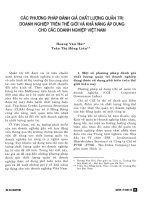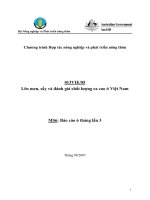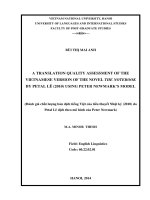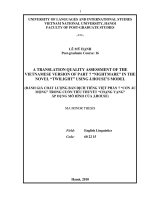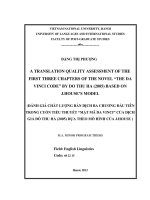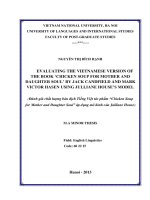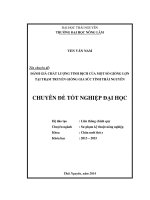đánh giá chất lượng bản dịch tiếng việt truyện harry potter và hòn đá phù thủy trong tiểu thuyết harry potter áp dụng mô hình của newmark
Bạn đang xem bản rút gọn của tài liệu. Xem và tải ngay bản đầy đủ của tài liệu tại đây (6.66 MB, 49 trang )
VIETNAM NATIONAL UNIVERSITY, HANOI
UNIVERSITY OF LANGUAGES AND INTERNATIONAL STUDIES
FACULTY OF POST-GRADUATE STUDIES
HOÀNG THỊ HẰNG NGA
A TRANSLATION QUALITY ASSESSMENT OF THE
VIETNAMESE VERSION OF THE BOOK “HARRY
POTTER AND THE PHILOSOPHER’S STONE” IN THE
SERIES HARRY POTTER USING NEWMARK’S MODEL
(Đánh giá chất lượng bản dịch tiếng Việt truyện “Harry Potter và hòn đá
phù thủy” trong tiểu thuyết Harry Potter áp dụng mô hình của
Newmark)
M.A. MINOR PROGRAMME THESIS
Field: English Linguistics
Code: 60.22.02.01
HANOI, 2014
VIETNAM NATIONAL UNIVERSITY, HANOI
UNIVERSITY OF LANGUAGES AND INTERNATIONAL STUDIES
FACULTY OF POST-GRADUATE STUDIES
HOÀNG THỊ HẰNG NGA
A TRANSLATION QUALITY ASSESSMENT OF THE
VIETNAMESE VERSION OF THE BOOK “HARRY
POTTER AND THE PHILOSOPHER’S STONE” IN THE
SERIES HARRY POTTER USING NEWMARK’S MODEL
(Đánh giá chất lượng bản dịch tiếng Việt truyện “Harry Potter và hòn đá
phù thủy” trong tiểu thuyết Harry Potter áp dụng mô hình của
Newmark)
M.A. MINOR PROGRAMME THESIS
Field: English Linguistics
Code: 60.22.02.01
Supervisor: Assoc. Prof. Dr. Lê Hùng Tiến
HANOI, 2014
i
DECLARATION OF AUTHORSHIP
I hereby state that the thesis entitled “A translation quality assessment of the
book Harry Potter and the Philosopher’s stone in the series Harry Potter
using Newmark‟s model” and the work presented in it is entirely my own for
the Degree of Master of Arts at University of Languages and International
Studies, Vietnam National University, Hanoi, and this work has not been
submitted for any degree at any other university or tertiary institution.
Hanoi, July 2014
Student
Hoàng Thị Hằng Nga
ii
ACKNOWLEDGEMENTS
First and foremost I would like to express my sincerest gratitude to my
supervisor, Assoc. Prof. Dr. Le Hung Tien, for the continuous support of my
study with his patience, motivation, enthusiasm, and immense knowledge. I
owe him a debt of gratitude that cannot be measured.
I also wish to acknowledge my debt to all the teachers of the
Department of Post Graduate Studies at College of Foreign Languages,
Vietnam National University for their useful lectures, assistance and
enthusiasm during my course.
Last but not least, I am grateful to my parents and all my family, from
whom I have received a lot of valuable support and encouragement.
On the whole, without all these help my thesis would not have possibly
been completed.
iii
ABSTRACT
There is a fact that there have been more and more literary translations
due to the process of globalization. Therefore, it is necessary to control the
quality of the translation so that the readers can enjoy the best of the foreign
literary works. This thesis is an attempt to assess the quality of a literary
translation, specifically chapter seven “The sorting hat” excerpting from the
novel “Harry Potter and the Philosopher’s stone”, basing on the schema of
Translation Quality Assessment proposed by Newmark. By this way, the
writer has found out that the translation has obtained a certain success.
However, it still reveals some mismatches between the source text and the
target text especially in terms of semantics. In addition, some other mistakes
which may affect the conciseness of the translation are also pointed out. From
the basis of the findings, some implications are made along with suggestions
for further studies.
iv
LIST OF ABBREVIATIONS
ST: Source Text
TT: Target Text
SL: Source Language
TL: Target Language
v
LIST OF TABLES
Table 1: Omission and addition in the translation 18
Table 2: Comparing two versions in terms of the titles 19
Table 3: Comparing two versions in terms of paragraphing 21
Table 4: Comparing two versions in terms of relative clauses 23
Table 5: Comparing two versions in terms of passive and active forms 24
Table 6: Comparing two versions in terms of pronouns and proper names 25
Table 7: Comparing two versions in terms of idioms 27
Table 8: Comparing two versions in terms of word choice and expression 30
Table 9: Mistakes in the translation in terms of grammar and meaning 33
vi
TABLE OF CONTENTS
DECLARATION OF AUTHORSHIP i
ACKNOWLEDGEMENTS ii
ABSTRACT iii
LIST OF ABBREVIATIONS iv
LIST OF TABLES v
TABLE OF CONTENTS vi
PART A. INTRODUCTION
1. Rationale for the study 1
2. Objective of the study 1
3. Research questions 2
4. Scope of the study 2
5. Method of the study 2
6. Organization of the study 3
PART B. DEVELOPMENT
CHAPTER 1. LITERATURE REVIEW
1.1. Translation Theory 4
1.1.1. Definition of Translation 4
1.1.2. Translation Methods 4
1.1.3. Translation Equivalence 5
1.2. Contrastive Analysis 7
1.3. Translation Quality Assessment 8
1.3.1. Definition 8
1.3.2. Translation Quality Assessment models 9
1.3.2.1. Response-based approach 9
1.3.2.2. Text-based approach 10
1.3.2.3. Julianne House‟s functional – pragmatic approach 12
vii
1.3.2.4. Newmark‟s comprehensive criticism approach 13
CHAPTER 2 – APPLICATION OF NEWMARK’S MODEL FOR TRANSLATION
QUALITY ASSESSMENT OF CHAPTER SEVEN OF “HARRY POTTER AND THE
PHILOSOPHER’S STONE”
2.1. Step 1: A brief analysis of the SL text stressing its intention and its functional aspects 16
2.2. Step 2: the translator‟s interpretation of the SL text‟s purpose, his translation method and
the translation‟s likely readership 17
2.3. Step 3: A selective but representative detailed comparison of the translation with the
original 19
2.4. Step 4: An evaluation of the translation 31
2.4.1. An evaluation of the translation in the translator‟s term 31
2.4.2. An evaluation of the translation in the critic‟s term 35
2.4.3. Assess the translation as a piece of writing, independently of its original 35
2.5. An assessment of the likely place of the translation in the target language culture or
discipline 36
PART C. CONCLUSION
1. Concluding remarks 37
2. Limitations of the study and suggestions for further studies 38
REFERENCES 39
1
PART A. INTRODUCTION
1. Rationale for the study
“Translation is not merely an interlinguistic process. It is more
complex than replacing source language text with target language text and
includes cultural and educational nuances that can shape the options and
attitudes of recipients”. (Dingwaney and Maier, 1995). Translation performs a
crucial role in our understanding and lives as the globe seems smaller than
ever before based on information sharing and communicative advances. Thus,
not only linguists or scholars but many people who work in different fields
are concerned about translation. Translation is not an easy work, it is even
more challenging for translators with literary works. Nowadays in Vietnam,
there is a rapid growth of famous foreign literary works which have
diversified the literature. It can not be denied that there is a number of works
that have received love and positive attitude from readers. Besides, there still
exist some works of bad quality which have received criticism from both
publication and profession. Thus, there is necessary to evaluate the
translations, especially literary works.
There are criteria for translation quality assessment which have been
addressed by different linguists such as Nida, J.House, Newmark…. From the
writer‟s point of view, among the suggested models, Newmark‟s model is a
good one which can be used to assess translation quality. The writer has taken
the translation version of the book “Harry Potter and the Philosopher’s
stone” by Ly Lan in the series Harry Potter by J.K Rowling to measure how
good the translation is.
2. Objective of the study
This study aims to make a comparison and analyze the ST and the TT
according to Newmark‟s model to assess the quality of the Vietnamese
2
translation of chapter seven in the book “’Harry Potter and the Philosopher’s
stone”, find out some problems of literary translations and draw some
suggestions for this field of translation.
3. Research questions
At the end of this study, the study will answer the following questions:
- How good is the Vietnamese version of chapter seven of the book
“Harry Potter and the Philosopher’s stone” according to Newmark’s model?
- What might be some implications from the translation?
4. Scope of the study
Harry Potter is a famous series all over the world. It includes seven
books corresponding seven adventures of Harry Potter in Hogwarts – school
of wizardry. Since the release of the first novel, “Harry Potter and the
Philosopher's Stone”, the books have gained immense popularity, critical
acclaim and commercial success worldwide. The series has been translated
into 67 languages, placing Rowling among the most translated authors in
history. With such a limit set out at the beginning of the study, all the analysis
and comparison between the ST and the TT is only restricted in chapter seven
of the book. As referred to earlier, Newmark‟s model is adopted to assess the
quality of the translation in this research.
5. Method of the study
The research utilizes qualitative design. Moreover, descriptive and contrastive
techniques are employed to evaluate the translation text. The original text will be
read thoroughly and comprehensively then the ST will be compared to its
translation according to five steps of Newmark‟s model:
1. A brief analysis of the SL text stressing its intention and its
functional aspects
3
2. The translator's interpretation of the SL text‟s purpose, his translation
method and the translation‟s likely readership
3. A selective but representative detailed comparison of the translation
with the original
4. The evaluation of the translation: (a) in the translator‟s term, (b) in
the critic‟s term
5. Where appropriate, an assessment of the likely place of the
translation in the target language culture or discipline
6. Organization of the study
The study is presented in 3 parts:
Part A is the introduction which includes the rationale for the study, the
objective, the research questions, the scope, the method as well as the
organization of the study.
Part B includes 2 chapters. In chapter one, the Literature Review in
which some related concepts of literary translation, contrastive analysis and
typical models of translation quality assessment are discussed. In the second
chapter, the writer will apply Newmark‟s model with five steps to analyze and
evaluate the translation.
Part C is the conclusion including the conclusions, implications,
limitations and suggestions for further study.
4
PART B. DEVELOPMENT
CHAPTER 1: LITERATURE REVIEW
This chapter presents the theoretical background of the study including
some related concepts and typical models of translation quality assessment.
1.1. Translation theory
1.1.1 Definition of translation
There have been different definitions of translation so far. According to
Newmark (1981) “translation is a craft consisting in the attempt to replace a
written message and/or statement in one language by the same message
and/or statement in another language”. House (1977) states that translation is
the replacement of a text in the source language by a semantically and
pragmatically equivalent text in the target language. Sharing the same point of
view, Cartford (1965) defines translation as the replacement of a text in one
language (source language) by an equivalent in another language (target
language). The definitions of translation are diverse; however, they all share
the same sense that translation does not refer to language as a system but
language in use. Furthermore, the preservation of semantic, pragmatic and
textual aspects of meaning across two different languages needs emphasizing
in translation.
1.1.2. Translation methods
Basing on Newmark‟s classification, there are eight methods in
translating as follow
SL emphasis TL emphasis
Word-for-word translation Adaptation
Literal translation Free translation
Faithful translation Idiomatic translation
Semantic translation Communicative translation
5
- Word for word translation: The SL word is translated into another language
by their most common meanings, which can be out of context at times.
- Literal translation: The SL grammatical constructions are translated to their
nearest TL but the lexical words are translated singly, out of context.
- Faithful translation: The SL text is reproduced in its precise contextual
meaning under the constraints of the TL grammatical structures.
- Semantic translation: is the process of using semantic information to aid in
translation of data in one representation to another representation. Semantic
translation refers to that type of translation which takes into account the
aesthetic value of the SL text.
- Adaption: The text is rewritten considering the SL culture which is
converted to the TL where the themes, characters and plots are preserved.
- Free translation: It reproduces the matter without the manner or the content
without the form of the original.
- Idiomatic translation: It reproduces the „message‟ of the original and prefers
colloquialisms and idioms which do not exist in the original.
- Communicative translation: The exact contextual meaning of the original is
rendered in such a way that both content and language are readily acceptable
and comprehensible to the readership.
Among the above-mentioned methods, semantic and communicative
translation are the two most common ones which are often used in literary
translation.
1.1.3. Translation equivalence
In translation theory, equivalence is regarded as a central concept.
According to Pym (1992) “equivalence is supposed to define translation, and
translation, in turn, defines equivalence”. Equivalence is a relationship
between two texts in two languages, rather than between the languages
themselves.
6
From Nida‟s point of view, there are two typical equivalences, namely
formal equivalence and dynamic equivalence. The terms "dynamic
equivalence" and "formal equivalence" were originally coined to describe
ways of translating the Bible, but the two approaches are applicable to any
translation of any text. The first one centers on the form and content of the
message of the ST whereas dynamic equivalence is the "quality of a
translation in which the message of the original text has been so transported
into the receptor language that the response of the receptor is essentially like
that of the original receptors."
Baker (1992) extends the concept of equivalence to cover similarity in
ST and TT information flow and in the cohesive roles that ST and TT devices
play in their respective texts. She explores equivalence at different levels in
relation to the translation process such as grammatical, textual and pragmatic
aspects. Equivalence can appear at word level and above word level, when
translating from one language into another. Concerning grammatical
equivalence, she notes that grammatical rules may vary across languages and
this may pose some problems in terms of finding a direct correspondence in
the TL. Among these grammatical devices which might cause problems in
translation Baker focuses on number, tense and aspects, voice, person and
gender. With regard to textual equivalence, it refers to the equivalence
between a SL text and a TL text in terms of information and cohesion.
Texture is a very important feature in translation since it provides useful
guidelines for the comprehension and analysis of the ST which can help the
translator in his or her attempt to produce a cohesive and coherent text for the
TC audience in a specific context. Finally, pragmatic equivalence refers to
implicatures and strategies of avoidance during the translation process.
7
Koller (1979) categorizes equivalence into five types. According to the
scholar, there are five factors which can be argued to play a relevant role in
the specification of equivalence type. These five factors are also the five types
of equivalence. The first one is denotative equivalence in which the SL and
TL words refer to the same thing in the real world. This is the referential
identity between SL and TL units. Besides denotative value, SL and TL words
should produce the same communicative values in the mind of native
speakers of the two languages or the equivalence transmitted by specific
choices between synonymous expressions with respect to level of style
(register), the social and geographical dimension, frequency, etc. It is called
connotative equivalence. The third type is text-normative equivalence in
which The SL and TL words using the same or similar text types in their
respective languages. Fourthly, the receiver/ reader to whom the translation is
directed so as to achieve an intended effect determines pragmatic equivalence
type. The last type is formal equivalence in which the SL and TL having the
same formal-aesthetic features-orthographic or phonological features, etc.
1.2. Contrastive analysis
Contrastive Analysis has attracted many linguists with countless
debates. One of the most well-known definitions for contrastive analysis is
offered by Lado, R. In Linguistics Across Cultures. He claimed that "those
elements which are similar to [the learner's] native language will be simple
for him, and those elements that are different will be difficult" (1957).
Another definition is introduced by James (1980). In his point of view,
contrastive analysis is not concerned with classification, and, as the term
contrastive implies, it focuses on the difference between languages than in
their likenesses. Furthermore, contrastive analysis investigates the differences
between pairs (or small sets) of languages against the background of
8
similarities and with the purpose of providing input to applied disciplines
such as foreign language teaching and translation studies. With its largely
descriptive focus contrastive linguistics provides an interface between theory
and application. It makes use of theoretical findings and models of language
description but is driven by the objective of applicability. (Gast, V. 2011).
Contrastive analysis, therefore, is defined as a linguistic enterprise
aimed at producing inverted two-valued typologies (it is always concerned
with a pair of languages), and founded on the assumption that languages can
be compared.
1.3. Translation Quality Assessment
1.3.1 Definition
Newmark (1995) regards translation criticism or translation quality
assessment as a crucial link between translation theory and its practice and as
“the keystone of any course in comparative literature, or literature in
translation, and a component of any professional translation course with the
appropriate text-types as an exercise for criticism and discussion”. There is a
variety of definition on translation criticism. According to McAlester(1999),
“translation criticism consists in stating the appropriateness of a translation,
which naturally also implies a value judgment, which need not however be a
quantified one, though it should perhaps explicitly justified for it to be of any
value”. To be more comprehensive, Hewson (2011) says that translation
quality assessment “attempts to set out the interpretative potential of a
translation seen in the light of an establish interpretative frame work whose
origin lies in the source text”. Furthermore, “translation criticism is
evaluative, in that as it explores a translation‟s interpretative potential, it looks
at degrees of similarity to or divergence from the source text‟s perceived
interpretative potential”.
9
Concerning the assessment of translations, House (1997) has already
raised a question: “How do we know when a translation is good?”. There are
some ideas expressing the views to evaluate a translation.
“Anecdotal reflections on the merits and weaknesses of translation have
been offered by generations of professional translators, poets and writers,
philologists and philosophers. The status and relative weight of criteria such as the
“faithfulness to the original”, “retention of the original‟s special flavour”,
“preservation of the spirit of the source language” as opposed to concentrating on
“a natural flow of the translated text” and the “pleasure and delight of the reader of
the translation” have been discussed at great length”. (House , 1997). She also
points out that most of the anecdotal approaches to the evaluation of translation
emphasize the belief that the quality of a translation depends largely on the
translator‟s subjective interpretation and transfer decisions, which are based on his
linguistic and cultural intuitive knowledge and experience. However, determining
whether the translation is good or not should be based on a special model of
quality translation assessment, not on the human‟ feelings or factors. Thus, in the
next part, some of the outstanding quality translation assessment models will be
presented with the aim to provide necessary information before applying the
model to evaluate the translated version of the novel.
1.3.2. Translation Quality Assessment models
1.3.2.1 Response – based approach
As mentioned in the previous part, most of the anecdotal approaches to
the evaluation of translation base on the translator‟s linguistic and cultural
intuitive knowledge and experiences. We can state that these approach are
unenlightening, as they represent a narrow and selective view of translation
one-sidedly emphasizing one aspect of translation :the process of
comprehension and interpretation on the part of the translator.
10
Another view for translation quality assessment is response – based.
One of the representatives of this approach is Nida. Nida‟s three criteria for
assessing the quality of a translation are programmatic and general :
“1.general efficiency of the communication process, 2. comprehension of
intent, 3. equivalence of response.” The third and most important criterion is,
of course, closely related to Nida‟s well-known basic principle of “Dynamic
(or Functional) Equivalence of a Translation”, the manner in which receptors
of the translation text respond to the translation text must be equivalent to the
manner in which receptors of the translation text respond to the source text.
Three similar criteria are suggested by Nida and Taber (1969): the correctness
with which the receptors understand the message of the original, the ease of
comprehension and the involvement a person experiences as a result of the
adequacy of the form of the translation. Again, these behavioral criteria need to
be further explained and put to the practical test: the crucial question then
remains whether the responses in question can be measured. Nida and Taber
themselves suggested some practical tests. However, each of the test has its
own shortcomings. The major weakness of all response-based suggestions for
translation evaluation, as J. House analyzed, is the weakness of all behaviour-
centered approached : the “black box”, the human mind is not taken into
account, such that, for instance, tests involving expert judges, must take criteria
for granted that need to be developed and made explicit in the first place.
1.3.2.2. Text-based approach
In this approach, the source text, its linguistic and textual structure and
its meaning potential at various levels (including the level of context of
situation in a systemic framework), is seen as the most important, indeed
constitutive factor in translation. Koller (1974) introduced three steps for
translation quality assessment. The first step is to consider the transferability
11
of the original text. If the original text is transferable, we have the most
equivalent translation. If the original text is untransferable, we have no
equivalence or no translation is made. The source text should be remained the
same. The second step is to re-translate the target text into the source
language. A translation is acceptable if the target text is similar in meaning
with the source text after it is re-translated. Finally, the third step is to have
the translation proof-read by native speakers of the target language. A
translation must satisfy readers as native speakers of the target language.
Although presenting insightful, original and stimulating ideas, Koller does not
go beyond a very general outline with no suggestions for operationalization.
Reiss‟s work (1970) is based on the concept of equivalence, but
considers the text, rather than the word or sentence, as the level at which
communication is achieved and at which equivalence must be sought. Reiss‟s
functional approach aims primarily to systematize translation evaluation.
Reiss believes that the “transmission of the predominant function of the
source text is the determining factor by which the target text is judged” and
proposes “specific translation methods according to text type”. She suggested
that different types of texts can be differentiated to the basis of three functions
of language : content-oriented texts, e.g.news, scientific-technical texts, form-
oriented texts, such as poems and literary genres, and conative texts, e.g.
advertisements and texts of a persuasive bent. The determination of the
textual types presupposes a careful analysis of the source text, but the
suggestions are not explicit enough, she gives no clear indication as to how
one should go about establishing language functions and a source text types.
Further, at what level of delicacy this can and should be done is left
unexplained. Thus, it needs to be further developed and made more concrete
in order to form a workable model of translation quality assessment.
12
1.3.2.3. Julianne House’s functional – pragmatic approach
House (1977) is in favour of semantic and pragmatic equivalence and
argues that source text and target text should match one another in function. She
gives a model for translation quality assessment which is based on pragmatic
theories of language. It attempts to avoid anecdotalism, reductionism,
programmatic statements and intuitively implausible one-sided considerations of
the source text and target text alone. The key point in her model is to compare
function of the source text and the target text; therefore, to understand her model,
it is necessary to understand “function” of an individual text which is different
from function of language. She states that the “function of a text is the
application or use which the text has in the context of a situation”. The function
consisting of an ideational and interpersonal functional component is equivalent
to that of the original. An initial analysis of the original according to a set of
situational dimensions for which linguistic correlates are established will be
made. Then, there will be a comparison of both the original‟s and the
translation‟s textual profits and functions. In this comparison, some mismatches
will occur. Any mismatch along the dimensions is an error which is then
categorized into covertly erroneous errors and overtly erroneous errors.
1) Covertly erroneous errors: those which result from a mismatch in one
situational dimension
2) Overtly erroneous errors: those which result from a non-dimensional
mismatch. Such errors can be divided into:
- Breaches of the target language system
- Mistakes in the denotative meanings in source text and target text
The final stage in House‟s model is to list both covertly and overtly
erroneous errors and a statement of the relative match of the two functional
components is made.
13
In her revisited model, she gives a clearer scheme for analyzing and
comparing original and translation texts. In general, the application of her
new model enables us to examine a text on four different levels: Function,
Register and Language.
According to Le. (2006), the model of House has a clear linguistically
theoretical base and concrete, detailed steps. However, this model also
requires linguistic knowledge and high occupational skills of the critics and
the criticism mainly aims at researching languages and translation. Therefore,
this model has not been applied widely and just at experimental level in
translation studies.
1.3.2.4. Newmark’s comprehensive criticism approach
Newmark was an English professor of translation. In his book “a text
book of translation” (1995), he presents his own model for translation quality
assessment called “comprehensive criticism of a translation” including five
steps :
1. A brief analysis of the SL text stressing its intention and its functional
aspects
2. The translator's interpretation of the SL text‟s purpose, his translation
method and the translation‟s likely readership
3. A selective but representative detailed comparison of the translation with
the original
4. The evaluation of the translation: (a) in the translator‟s term, (b) in the
critic‟s term
5. Where appropriate, an assessment of the likely place of the translation in
the target language culture or discipline
In the first step, the critic has to try to point out the author‟s purpose,
that is, the attitude he takes towards the topic; characterization of the readers
14
that the literary work aims at ; an indication of its category and type. The
critic assesses the quality of the language to determine the translator‟s degree
of license. In this step, the critic can briefly state the topic or themes but
avoids retelling the plot. He also doesn‟t need to spend time discussing the
author‟s life, other works unless they may help to understand the text.
In the second step, the critic attempts to see the text from the point of
view of the translator, is sometimes overlooked in translation criticism. The
critic has to review whether the translator has omitted any section of the
original text and whether it affects the message that author wishes to express.
Moreover, it is important to find out if any text is over-translated and to what
extent the cultural meaning of the original text has been changed or
transferred to the target culture. In interpreting the translator‟s intention and
procedures, the critic tries not to criticize but to find out why he has used
these procedures. Finally, in any event, the critic empathizes with the
translator and distinguish between incompetence (inadequate knowledge of
source and/or topic) and a translation method which may be too idiomatic or
too academic for his own tastes but which appears consistent.
The third step is the heart of the critique. The critic considers how the
translator has solved the particular problems of the source language text. He
has to group them under heads such as the title, the structure, including the
paragraphing and sentence connectives; shifts; metaphors; cultural words;
translationese; proper names In this step, the critique should consist of a
discussion of translation problems and not quick recipes for a correct or a
better translation. Normally, in this section, the critic has to choose the most
selective and representative examples of the achievements and weaknesses of
the translated version in comparison with the original text.
15
Fourthly, the critic will evaluate the referential and pragmatic accuracy
of the translation at three levels: first by the translator‟s standards, second by
the critic‟s standards, and last as a piece of writing, independently of its
original. In the first two criteria, besides evaluating the achievements of the
translation, the critic has to find out if there is any semantic deficits in the
translation and what are the causes of this, In the last criteria, he has to assess
whether the translated version is written in a natural manner, that is, neat,
elegant and agreeable or not.
In the last step, especially in the case of literary works such as poems,
stories or novels, it is essential to assess the work‟s potential importance
within the target language‟s literature by asking such questions as “Was it in
fact worth translating?”, “Does it have any influence on the target language‟s
literature and culture?”.
Although Newmark‟s model is not as clear and well theoretically based
as in the case of House‟s, it has many strong points in terms of application.
This is due to the fact that these steps are initiated from the practical
experiences of the translators. Moreover, it reflects the problems and the
concerns of the translators in the translation process; therefore, it is easy to be
carried out. For those reasons, in this thesis, the writer decide to apply
Newmark‟s model for translation quality assessment of chapter 7 of the book
“Harry Potter and the Philosopher‟s stone”.
16
CHAPTER 2 – APPLICATION OF NEWMARK’S MODEL FOR
TRANSLATION QUALITY ASSESSMENT OF CHAPTER SEVEN OF
“HARRY POTTER AND THE PHILOSOPHER’S STONE”
This chapter will present the application of Newmark‟s translation
quality assessment model to assess the quality of the TT in chapter seven of
the book “Harry Potter and the Philosopher’s stone”. The ST will be
analyzed according to the five steps of Newmark‟s model.
2.1. Step 1: A brief analysis of the SL text stressing its intention and its
functional aspects
Harry Potter is a series of seven fantasy novels written by the British
author J. K. Rowling. The series were originally printed in English by two
major publishers, Bloomsbury in the United Kingdom and Scholastic Press in
the United States. The books later have been published by many publishers
worldwide.
“Harry Potter and the Philosopher's Stone” is the first novel in
the Harry Potter series. The plot follows Harry Potter who discovers his
magical heritage, as he makes close friends and a few enemies in his first
year. With the help of his friends, Harry faces an attempted comeback by the
dark wizard Lord Voldemort, who killed Harry's parents, but failed to kill
Harry when he was just one year old. The book, which was Rowling's debut
novel, was published on 26 June 1997 by Bloomsbury in London. In
1998, Scholastic Corporation published an edition for the United States
market under the title “Harry Potter and the Sorcerer's Stone”.
The novel has been translated into many languages,
placing Rowling
among the most translated authors in history.
The book has seen translations
to diverse languages. In Vietnam, the novel was translated directly by Ly Lan

